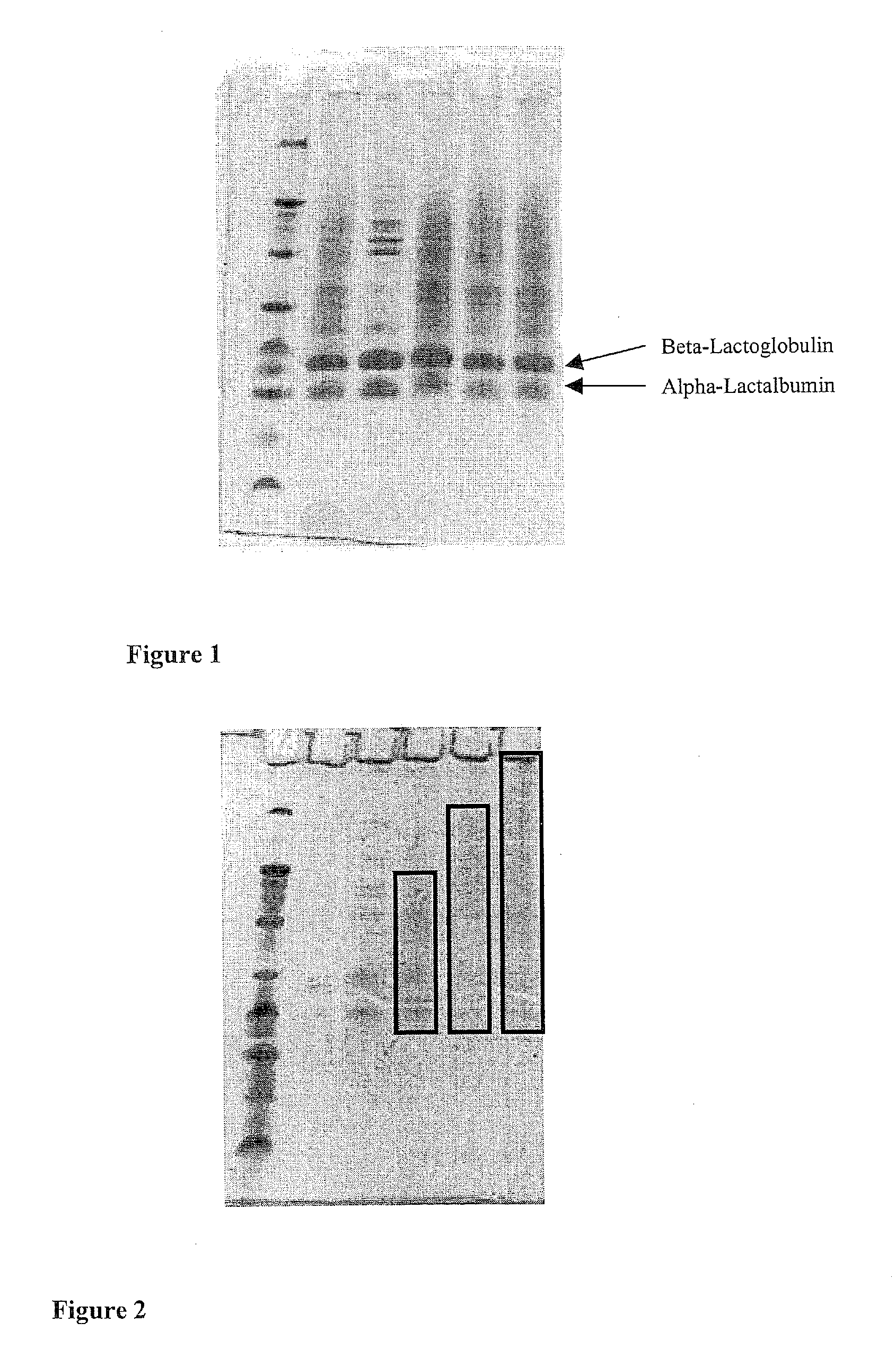Modified protein-based, low-carbohydrate food ingredient and process for making same
a technology of low-carbohydrate, protein-based food ingredients and process, which is applied in the field of protein-carbohydrate complexes, can solve the problems of unsuitable food application procedures, and achieve the effect of increasing emulsion stabilization and viscosity
- Summary
- Abstract
- Description
- Claims
- Application Information
AI Technical Summary
Benefits of technology
Problems solved by technology
Method used
Image
Examples
example 1
Materials
[0033]A MWP ingredient prepared according to the method of Hudson et al., supra. was obtained from Grande Custom Ingredients, Inc. (Grande Custom Ingredients Group, Lomira, Wis.). The MWP contained approximately 70.4% (w / w) protein and 7% lactose (w / w) and was used for all experiments. A commercial whey protein concentrate labeled Ultra 8000 was also obtained from Grande Custom Ingredients (Lomira, Wis.) for comparison purposes. Nitrogen content of the MWPC was analyzed by the Analytical Services Laboratory (Raleigh, N.C.) using a CHN Elemental Analyzer, Series II (Perkin Elmer Corporation, headquartered in Norwalk, Conn.). Protein content was calculated from the provided value using the equation (N×6.38) (Table 2). Dextran (35 kDa-200 kDa) from Leuconostoc mesenteroides was obtained from Sigma-Aldrich (St. Louis, Mo.). A Bicinchoninic Acid (BCA) Protein assay kit, o-Phthalaldehyde (OPA) Assay reagent, and Glycoprotein staining kit were obtained from Pierce (Rockford, Ill.)...
example 2
Preparation of MWP-CHO Complexes
[0034]Under acidic pH conditions, the nucleophilic amino groups of MWP are attacked by electrophilic carbonyl groups of polysaccharides through electrostatic attractions. Nurston, H. 2005. The Maillard reaction; chemistry, biochemistry, and implications. Royal Society of Chemistry. pp 7-8. Prolonged heat treatment further induces protein conformational changes, exposing reactive basic residues leading to increased covalent bonding. As a result, protein-carbohydrate conjugation is induced, thereby preventing dissociation. Ledward, D. A. Protein-polysaccharide interactions. In Protein functionality in food system N. S. Hettierachchy, N. S.; Ziegler, G. R., Ed.; Marcel Dekker, New York, 1994; pp 225-259; see also Samant, S.; Singhal, R.; Kulkarn, P. R.; Rage, D. Review: Protein-polysaccharide interactions: a new approach in food formulations. Int. J. Food Sci. Tech., 1993, 28, 247-562.
[0035]Initially, investigation into the appropriate ratio of protein t...
example 3
Determination of Protein Content in Samples
[0036]The bicinchoninic acid (BCA) assay is a colorimetric method for measuring protein concentration in a given sample. The first step is a Biuret reaction that reduces Cu+2 to Cu+, followed by BCA forming a complex with Cu+1 and producing a purple color detectable at 562 nm. Weichelmen, K. J., Braun, R. D., Fitzpatrick, J. D. 1988. Investigation of the bicinchoninic acid protein assay: identification of the groups responsible for color formation. Anal. Biochem. Nov. 15; 175(1): 231-7.
[0037]All samples were hydrated in DI water for >24 hours at 4° C. prior to testing. The samples were diluted 1:30 (protein solution to DI water) to ensure they were in the acceptable range of 0 to 2 mg / ml to fit within the established standard curve. A standard curve was established by taking 5 test tubes containing 2 ml of BCA reagent and adding increasing amounts of albumin standard from 0 to 100 μl in increments of 25 μl. Deionized water was added to each...
PUM
 Login to View More
Login to View More Abstract
Description
Claims
Application Information
 Login to View More
Login to View More - R&D
- Intellectual Property
- Life Sciences
- Materials
- Tech Scout
- Unparalleled Data Quality
- Higher Quality Content
- 60% Fewer Hallucinations
Browse by: Latest US Patents, China's latest patents, Technical Efficacy Thesaurus, Application Domain, Technology Topic, Popular Technical Reports.
© 2025 PatSnap. All rights reserved.Legal|Privacy policy|Modern Slavery Act Transparency Statement|Sitemap|About US| Contact US: help@patsnap.com



